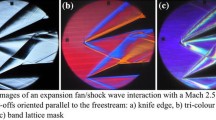Abstract
The principles of experimental visualization are widely used in developing numerical visualization techniques. Numerous techniques have been created by the simulation of experimental techniques, such as dye, smoke, surface oil, and optical techniques. In this research, a numerical visualization technique is proposed by the computational modeling of the visualization process of hydraulic analogy. First, the principle and implementation of the current technique are introduced and defined, respectively. Then, flow datasets of double Mach reflection and Rayleigh–Taylor instability are used for examining the display effects of the current technique. The effects of physical parameters and specific heat ratio on the current technique are investigated. In addition, the current technique is compared with six other techniques. The comparison indicates that the current technique not only can accurately display shock waves and slip lines, but also has an advantage in stereoscopically and cleanly visualizing vortices. Furthermore, the relationship between the current technique and numerical Schlieren and Shadowgraph is discussed. The current technique is further improved for the presentation of the information of colors and illumination. Finally, the limits of the current technique are highlighted.
Graphical abstract













Similar content being viewed by others
References
Buchanan A, Macartney R, Thompson MC et al (2007) Hydraulic analogy study of supersonic rectangular-jet screech control with cylinders. AIAA J 45:1539–1545
Dauptain A, Cuenot BM, Gicquel LY (2010) Large eddy simulation of stable supersonic jet impinging on flat plate. AIAA J 48:2325–2338
De Leeuw WC, Pagendarm HG, Post FH et al (1995) Visual simulation of experimental oil-flow visualization by spot noise images from numerical flow simulation. In: Scateni R, van Wijk JJ, Zanarini P (eds) Visualization in scientific computing’95. Springer, Vienna, pp 135–148
Drebin R A, Carpenter L, Hanrahan P (1988) Volume rendering. In: ACM Siggraph computer graphics, vol 22, no 4. ACM, pp 65–74
Gvozdeva LG, Predvoditeleva OA, Fokeev VP (1968) Double Mach reflection of strong shock waves. Fluid Dyn+ 3:6–11
Hadjadj A, Kudryavtsev A (2005) Computation and flow visualization in high-speed aerodynamics. J Turbul 6:N16
Heller HH, Bliss DB (1975) Aerodynamically induced resonance in rectangular cavities—physical mechanisms and suppression concepts. No: AFFDL-TR-74-133
Jeong J, Hussain F (1995) On the identification of a vortex. J Fluid Mech 285:69–94
Jobard B, Lefer W (1997) Creating evenly-spaced streamlines of arbitrary density. In: Lefer W, Grave M (eds) Visualization in scientific computing’97. Springer, Vienna, pp 43–55
Klein EJ (1965) Interaction of a shock wave and a wedge-an application of the hydraulic analogy. AIAA J 3:801–808
Laramee RS, Hauser H, Doleisch H et al (2004) The state of the art in flow visualization: dense and texture-based techniques. Comput Graph Forum 23(2):203–221
Li GS, Xavier T, Charles H (2008) Physically-based dye advection for flow visualization. Comput Graph Forum 27:727–734
Liu X, Zhang S, Zhang H et al (2015) A new class of central compact schemes with spectral-like resolution II: hybrid weighted nonlinear schemes. J Comput Phys 284:133–154
Loh WHT (1959) Hydraulic analogy for two-dimensional and one-dimensional flows. J Aerosp Sci 26:389–391
Peng Z, Laramee RS (2008) Vector glyphs for surfaces: a fast and simple glyph placement algorithm for adaptive resolution meshes. In: Proceedings of vision, modeling, and visualization 2008, pp 61–70
Post FH, Van Walsum T (1993) Fluid flow visualization. In: Hagen H, Müller H, Nielson GM (eds) Focus on scientific visualization. Springer, Berlin, pp 1–40
Quirk JJ (1998) AMRITA—a computational facility (for CFD modelling). In: VKI 29th CFD series, pp 23–27
Sadarjoen IA, Post FH (2000) Detection, quantification, and tracking of vortices using streamline geometry. Comput Graph UK 24:333–341
Schneider D, Wiebel A, Carr H et al (2008) Interactive comparison of scalar fields based on largest contours with applications to flow visualization. IEEE Trans Vis Comput Graph 14:1475–1482
Settles GS, Hargather MJ (2017) A review of recent developments in Schlieren and Shadowgraph techniques. Meas Sci Technol 28:042001
Shadden SC, Lekien F, Marsden JE (2005) Definition and properties of Lagrangian coherent structures from finite-time Lyapunov exponents in two-dimensional aperiodic flows. Physica D 212:271–304
Shi J, Zhang YT, Shu CW (2003) Resolution of high order WENO schemes for complicated flow structures. J Comput Phys 186:690–696
Tamura Y, Fujii K (1990) Visualization for computational fluid dynamics and the comparison with experiments. In: Flight simulation technologies conference and exhibit. No: AIAA-1990-3031
Tropea C, Yarin AL (2007) Springer handbook of experimental fluid mechanics. Springer, Berlin
Von Funck W, Weinkauf T, Theisel H et al (2008) Smoke surfaces: an interactive flow visualization technique inspired by real-world flow experiments. IEEE Trans Vis Comput Graph 14:1396–1403
Worthing AG (1912) On the deviation from Lambert’s cosine law of the emission from tungsten and carbon at glowing temperatures. Astrophys J 36:345
Yates LA (1993) Images constructed from computed flowfields. AIAA J 31:1877–1884
Zhang S, Jiang S, Zhang YT et al (2009) The mechanism of sound generation in the interaction between a shock wave and two counter-rotating vortices. Phys Fluids 21:076101
Acknowledgements
This study was supported and funded by the State Key Laboratory of Aerodynamics of China (No. SKLA2017-3-4).
Author information
Authors and Affiliations
Corresponding author
Rights and permissions
About this article
Cite this article
Liu, J., Cai, J., Yang, D. et al. A numerical visualization technique based on the hydraulic analogy. J Vis 22, 371–384 (2019). https://doi.org/10.1007/s12650-018-0539-6
Received:
Revised:
Accepted:
Published:
Issue Date:
DOI: https://doi.org/10.1007/s12650-018-0539-6




